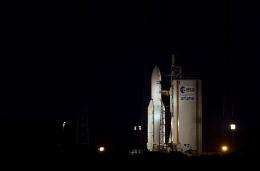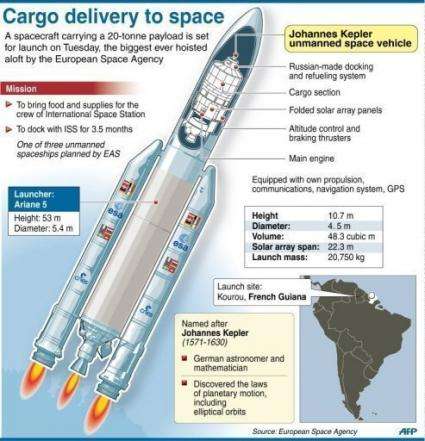European freighter docks with space station

A robot freighter laden with seven tonnes of supplies docked flawlessly on Thursday with the International Space Station (ISS), its European controllers said here.
The Johannes Kepler teamed up with the ISS at 1708 GMT after an eight-day orbital flight covering some four million kilometres (2.5 million miles), live coverage of the operation showed.
After the control room burst into applause, engineers began running through a checklist to ensure that the Automated Transfer Vehicle (ATV) had moored securely.
The operation was scheduled to be followed at 2150 GMT by the launch of Discovery, NASA's oldest and most journeyed space shuttle, whose trip to the ISS will be its final mission.
After liftoff aboard an Ariane 5 super-rocket on February 16, the supply ship used advanced navigation and onboard thrusters to automatically find its way to the ISS, orbiting at about 350 kilometres (218 miles).
The 20-tonne vehicle is designed to supply the ISS with air, food and spare parts and lift the sprawling station -- which, tugged by Earth's atmosphere, has lost altitude -- by some 50 kms (31 miles).
The giant cylindrical craft is the second out of five to be built by the European Space Agency (ESA) under its contract with the US-led ISS project.
Once emptied of its cargo, the Johannes Kepler will then be used as a spare room and for storage, easing cramped conditions for the ISS crew.

In early June, the ATV will undock, laden with rubbish, human waste and unwanted hardware, and then go on a suicide plunge, burning up over the South Pacific.
ESA's director for human spaceflight, Simonetta di Pippo, said the success of the ATV boosted hopes for "an era of autonomy" in space exploration.
"Thanks to its flexibility, we can think of a wide variety of new space vehicles," she said.
"ATV could evolve into a future re-entry spacecraft to support future orbital infrastructures and exploration missions, carrying people and supplies to lunar orbit.
"This is very important for us and for all our partners in the ISS programme since, after the withdrawal of the space shuttle, ATV will be the largest servicing vehicle left to support the station."
ESA has been widely praised for its unmanned missions to monitor Earth and explore other planets, but the agency has never had a human spaceflight capability.
Its astronauts hitch rides with the US space shuttle -- due to be phased out this year -- and Russia's Soyuz.
"In the ATV, there are technological elements which are absolutely fine for transporting astronauts," Olivier de la Bourdonnaye, director of the ATV 2 programme at Astrium Space Transportation, said in an interview earlier this month.
"The docking system and propulsion system in particular meet all the safety standards for manned flight. However, to carry a crew, you need a whole lot more, notably a spacecraft that can cope with re-entry."
The first step towards this has been taken with a study for a experimental re-entry vehicle which will carry back instruments back to Earth as a test of survival.
The Johannes Kepler is named after the great German mathematician of the 16th and 17th centuries who first calculated the movement of planetary bodies in elliptical orbits, paving the way for Newton's theories of gravitation.
The first ATV, the Jules Verne, flew in 2008.
(c) 2011 AFP





















